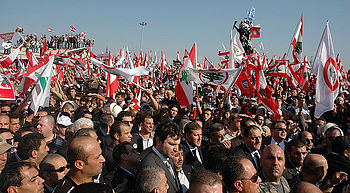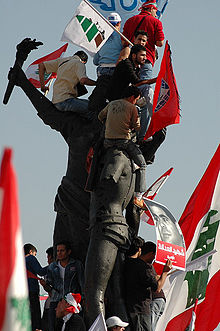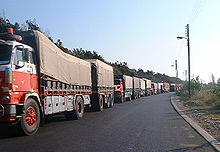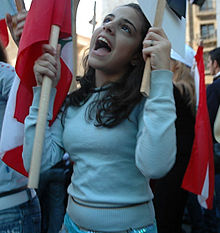- Cedar Revolution
-
series
Modern Lebanon 1958 Lebanon crisis Lebanese Civil War 1982 Lebanon War Syrian occupation of Lebanon 2005 Lebanon bombings Cedar Revolution 2006 Lebanon War 2006-8 political protests 2007 North Lebanon conflict 2008 conflict in Lebanon Topical Ancient history Timeline of Lebanese history The Cedar Revolution (Arabic: ثورة الأرز - thawrat al-arz) or Independence Intifada[1] (Arabic: انتفاضة الاستقلال- intifāḍat al-istiqlāl) was a chain of demonstrations in Lebanon (especially in the capital Beirut) triggered by the assassination of the former Lebanese Prime Minister Rafik Hariri on February 14, 2005.
The primary goals of the original activists were the withdrawal of Syrian troops from Lebanon and the replacement of a government heavily influenced by Syrian interests with more independent leadership, the establishment of an international commission to investigate the assassination of Prime Minister Hariri, the resignation of security officials to ensure the success of the plan, and the organization of free parliamentary elections. The demonstrators demanded the end of the Syrian influence in Lebanese politics. At the start of the demonstrations, Syria had been maintaining a force of roughly 14,000 soldiers and intelligence agents in Lebanon.[2] Following the demonstrations, the Syrian troops completely withdrew from Lebanon on April 27, 2005. The Pro-Syrian government was also disbanded, accomplishing the main goal of the revolution. (For background information on Syria's involvement in Lebanese politics, see the articles History of Lebanon, Lebanese Civil War, and Syrian occupation of Lebanon.)
The opposition has taken the white and red scarf, and the pro-Hariri blue ribbon, as its symbol. Popular mottos of the movement were Hurriyya, Siyada, Istiqlal (Freedom, Sovereignty, Independence), and Haqiqa, Hurriyya, Wahda wataniyya (Truth, Freedom, National unity).
Goals
The main goal of the cedar revolution was the ending of the Syrian military occupation of Lebanon which had lasted about 30 years (since 1976). In addition, many Lebanese called for the return of former Prime Minister Michel Aoun, in exile since 1991, and the release of the imprisoned Lebanese Forces leader Samir Geagea as a goal of the revolution.
Some goals whose accomplishment is sometimes cited in order for the revolution to end include:
- Uniting all Lebanese in their fight for freedom and independence
- Ousting Karami's Pro-Syrian regime
- Firing the six Lebanese commanders of the nation's main security services along with the State Prosecutor
- Executing the complete withdrawal of the Syrian troops and their security services from Lebanon
- Unmasking the killers of former Prime Minister Rafik Hariri
- Running free and democratic parliament elections in spring 2005 free from Syrian interference
Origins of the name
The name "Cedar Revolution" is a term that was coined by the U.S. Under Secretary of State for Global Affairs Paula J. Dobriansky in a news conference,[3][4] and used to draw a comparison with the Rose Revolution of Georgia, the Orange Revolution of Ukraine, and the "Purple Revolution" of Iraq.
In the Arab world, including Lebanon, it is better known as Lebanon's Intifadat-al-Istiqlal (Independence Uprising). The term was coined by Democratic Left Movement Leaders Samir Kassir and Hikmat Eid; they stressed the term Intifada to give the uprising an Arab meaning by linking it to the Palestinian Intifada and the term independence to stress its liberation side. Other names include the Cedar Spring (Arabic: ربيع الأرز - Rabi' el Arz),[5] in reference to the prevailing season when protests first broke out, and also as an allusion to famous freedom and independence movements like the Prague Spring and Damascus Spring.[6] The names used by the local media, like the LBC and Future TV, to describe this event include Lebanon Independence (Istiqlal Lubnan), Lebanon Spring (Rabi' Lubnan), or just Independence 05.
The word Cedar refers to a national emblem, the Cedar of Lebanon, a tree featured on the flag of Lebanon.
Groups involved in the revolution
Civilian groups and organizations
- Qornet Shehwan Gathering (Liqa' Qornet Shehwan)
- Citizens for a Free Lebanon: Non-governmental organization
- The Center for Democracy in Lebanon: Non-governmental grass-root movement
- The Global Organization of Democratic Believers: An all volunteer group of various religious backgrounds
Main political parties involved in the revolution
In Alphabetical Order:
- Democratic Renewal Movement (Harakat Al-Tajadod Al-Dimokrati) Multi-confessional Movement Leader: Nassib Lahoud, former MP and presidential hopeful.
- Democratic Left (Al Yassar Al Dimokrati) Multi-Confessional Movement Leader: Elias Atallah, former MP and former member of the communist party
- Free Patriotic Movement (At Tayyar Al-Watani Al-Horr) Christian Movement Leader: Michel Aoun, MP. Also presides the "Change and Reform" coalition. He was one of the first to demand the Syrian withdrawal. The movement left the 14 March coalition before the 2005 elections after General Aoun came back from his Paris exile.
- Future Movement (Tayyar Al Mustaqbal) Muslim Sunni Movement Leader: Saad Hariri, MP and son of Rafiq Hariri
- Lebanese Forces (Al Kuwwat al Lubnaniyya) Christian Party Leader: Samir Geagea, jailed 11 years by the Syrians
- Lebanese Liberation Movement Leader: unknown
- Lebanese National Bloc (Hizb Al Kitla Al Wataniya) Christian Party Leader: Carlos Eddé nephew of former leader Raymond Eddé. The Lebanese National Bloc left the 14 March Coalition in June 2009 after the parliamentary election
- National Liberal Party (Hizb Al-Wataniyin Al-Ahrar) Christian Party Leader: Dory Chamoun, son of former President Camille Chamoun
- Phalangist Party (Al-Kataeb Al-Loubnaniya) Christian Party Leader: Amin Gemayel, former President of Republic.
- Progressive Socialist Party (Hizb al-Taqadummi al-Ishtiraki) Druze Party Leader: Walid Jumblat, MP and son of former leader Kamal Jumblat; The PSP left the 14 March Coalition in August 2009
- Armenian Democratic Liberal Party (Hizb al-Ramgavar) MP Jean Ogassapian.
- Social Democrat Hunchakian Party (Hizb al-Henchag) MP Sebouh Kalpakian.
Background
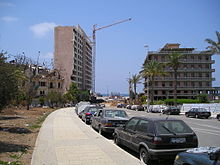 Rue Minet al Hosn where Rafik Hariri was assassinated on February 14, 2005.
Rue Minet al Hosn where Rafik Hariri was assassinated on February 14, 2005.
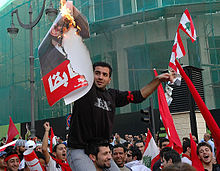 Anti-Syrian protesters burning posters of President Émile Lahoud
Anti-Syrian protesters burning posters of President Émile Lahoud
On February 14, 2005, the former Lebanese Prime Minister Rafik Hariri was assassinated in a truck bomb attack, which killed 21 and wounded nearly 100. Former Minister of Economy and Trade Bassel Fleihan later died as well from injuries sustained in the blast. This attack sparked huge demonstrations that seemed to unite large numbers of citizens from the usually fractured and sectarian Lebanese population. It was the second such incident in four months: former minister and MP Marwan Hamadeh had survived a car bomb attack on October 1, 2004.
Within hours of the assassination, Lebanese prosecutors issued warrants for the arrest of six Australian nationals who flew out of Beirut to Sydney, Australia three hours after the explosion claiming that seats occupied by the men had tested positive for traces of explosives, and that they were traveling without luggage. The Australian Federal Police interviewed ten individuals in Sydney upon the arrival of the flight, and found the men they questioned did have luggage. Although Sydney air port security sniffer dogs trained to find explosives did react to aircraft seats occupied by the men,[7] test swabs taken from three of the men by the Australian Federal Police tested negative for explosives. Within 48 hours, the Australian Federal Police absolved the six of any involvement in the assassination, giving little credibility to claims of the Lebanese officials.
Despite the lack, to date, of any actual substantial evidence implicating any party or individual, the Syrian government has borne the brunt of Lebanese and international outrage at the murder, because of its extensive military and intelligence influence in Lebanon, as well as the public rift between Hariri and Damascus just before his last resignation on October 20, 2004. The day after Hariri's resignation, pro-Syrian former Prime Minister Omar Karami was appointed Prime Minister.[8]
Lebanese Druze leader Walid Jumblatt, a recent adherent to the anti-Syrian opposition, emboldened by popular anger and civic action, alleged in the wake of the assassination that in August 2004 Syrian President Bashar al-Assad threatened Hariri, saying "[President of Lebanon] Lahoud is me. ... If you and Chirac want me out of Lebanon, I will break Lebanon."[9] He was quoted as saying "When I heard him telling us those words, I knew that it was his condemnation of death." The United States, the EU and the UN have stopped short of any accusations, choosing instead to demand a Syrian pullout from Lebanon and an open and international investigation of the Assassination. Jumblatt's comments are not without controversy; the BBC describes him as "being seen by many as the country's political weathervane" - consistently changing allegiances to emerge on the winning side of the issues de jour through the turmoil of the 1975-90 civil war and its troubled aftermath.[10] He was a supporter of Syria after the war but switched sides after the death of former Syrian president Hafez al-Assad in 2000. His account is quoted, but not confirmed, in the UN's FitzGerald Report. The report stops short of directly accusing Damascus or any other party, saying that only a further thorough international inquest can identify the culprit.[11] The Lebanese government has agreed to this inquiry, though calling for the full participation, not supremacy, of its own agencies and the respect of Lebanese sovereignty.[12] (See international reaction below.)
On February 21, 2005 tens of thousands of Lebanese protestors held a rally at the site of the assassination calling for an end of Syrian occupation and blaming Syria and the pro-Syrian president Emile Lahoud for the murder. In the subsequent weeks, nearly every Monday, a demonstration has been held at Beirut's Martyrs Square (also referred to by protestors as "Liberty Square"), in addition to the constant daily gathering of Lebanese there.[13]
Similar demonstrations by Lebanese immigrants have also taken place in several cities across the world, including Sydney - Australia (where over 10,000 people demonstrated in the city), San Francisco, Paris, Düsseldorf, Montreal, and London.
Government resignation
Lebanon 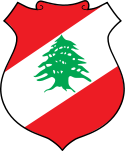
This article is part of the series:
Politics and government of
LebanonPresidencyGovernment- Prime Minister
- Cabinet
Legislature- Parliament
- Current members
- Presidential 2008
- Parliamentary 2009
- Local 2010
Other issues- Governorates
- Districts
- Municipalities
- Armed Forces
- Human rights
- Foreign relations
Daily protests against the Syrian occupation attracted 25,000 people. While in the 1990s most anti-Syrian demonstrations were predominantly Christian and were put down by force, the new demonstrations were distinctly non-sectarian and the government did not respond with force or intimidation.[14]
On February 28 the government of pro-Syrian prime minister Omar Karami resigned, calling for a new election to take place. Karami said in his announcement: "I am keen the government will not be a hurdle in front of those who want the good for this country". The tens of thousands gathered at Beirut's Martyrs' Square cheered the announcement, then chanted "Karami has fallen, your turn will come, Lahoud, and yours, Bashar".[15]
Opposition MPs were not satisfied with only Karami's resignation, and kept pressing for full Syrian withdrawal. Former minister and MP Marwan Hamadeh, who survived a similar car bomb attack on October 1, 2004, said "I accuse this government of incitement, negligence and shortcomings at the least, and of covering up its planning at the most... if not executing".
On March 23, Michel Abu Arraj, the Lebanese magistrate responsible for the internal Lebanese investigation of the assassination asked to be excused, citing a heavy court schedule. The Judicial Council of Lebanon is expected to rule on his request shortly.[16] His resignation and the consequent need to replace him may result in a delay in the investigation.
International reaction
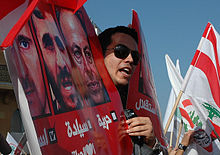 Protester holding a poster condemning Emile Lahoud, Bashar Assad, Mahmoud Ahmedinajad
Protester holding a poster condemning Emile Lahoud, Bashar Assad, Mahmoud Ahmedinajad
Hariri's murder triggered increased international pressure on Syria. In a joint statement, U.S. President George W. Bush and French president Jacques Chirac condemned the killing and called for full implementation of UN Security Council Resolution 1559, which requires the withdrawal of Syrian troops from Lebanon and the disarming of the Hezbollah group thriving in southern Lebanon.
At one point there seemed to be confusion about the extent to which Syria was willing to withdraw from Lebanon. Arab League head Amr Moussa declared that Syrian president Assad promised him a phased withdrawal over a two-year period, but the Syrian Information Minister Mahdi Dakhlallah said that Moussa had misunderstood the Syrian leader. Dakhlallah said that Syria will merely move its troops to eastern Lebanon. Since then, Syria has declared that Resolution 1559 will be fully complied with, and in a matter of months rather than years.
On March 15, upon hearing purportedly leaked information that the United Nations' special investigation may have found that the Lebanese authorities covered up evidence of the murder, Columnist Robert Fisk alleges that Hariri's two sons fled Lebanon, reportedly after being warned that they too were in danger of assassination.[17]
UN Secretary-General Kofi Annan, in response to a request by the Security Council, sent a team of Irish, Egyptian and Moroccan specialists, led by Ireland's deputy police commissioner, Peter FitzGerald, to investigate the assassination. Even before the FitzGerald Report was published, Annan has said a further, more comprehensive investigation may be necessary. FitzGerald thanked the Lebanese government for its cooperation before departing.[18] The report cites the Syrian presence in Lebanon as a factor contributing to the instability and polarization that preceded the assassination. The report also criticizes the Lebanese government and intelligence agencies for the handling of their own investigation into the affair, calling it flawed and inconclusive. The Lebanese government in turn has described the report as "alien to reality" and criticized the UN team for not seeking broader government participation in the investigation. The government has agreed to a further, more comprehensive international inquiry, but insisted that any future inquiry would have to work with the government. At a press conference on March 25, Lebanese Foreign Minister Mahmoud Hammoud said the inquiry would be expected to work within an established framework "in co-operation with the state".[12]
Syrian reaction
On March 2, 2005, Syrian leader Bashar Assad announced that his troops would leave Lebanon completely "in the next few months". Responding to the announcement, opposition leader Walid Jumblatt said that he wanted to hear more specifics from Damascus about any withdrawal: "It's a nice gesture but 'next few months' is quite vague - we need a clear-cut timetable".[20]
On March 3, Germany and Russia (Syria's Cold War ally) joined those calling for Syria to comply with Resolution 1559. German Chancellor Gerhard Schröder said: "Lebanon should be given an opportunity for sovereignty and development and this can only be achieved by complying with Security Council resolutions that stipulate immediate Syrian withdrawal from Lebanon."[21]
The Russian Foreign Minister, Sergei Lavrov, stated that "Syria should withdraw from Lebanon, but we all have to make sure that this withdrawal does not violate the very fragile balance which we still have in Lebanon, which is a very difficult country ethnically."[22]
On March 5 Syrian leader Assad declared in a televised speech that Syria would withdraw its forces to the Bekaa Valley in eastern Lebanon, and then to the border between Syria and Lebanon. He did not provide a timetable for a complete withdrawal of Syrian forces from Lebanon.
On the weekend of April 9 and 10th, on the anniversary of the ignition of the Lebanese Civil war, the last remaining Syrian troops left Lebanon, ending their 30 year presence.[23]
Response from the Arab world
Several Arab states also joined in with the withdrawal demands. As Al-Assad arrived in Saudi Arabia for emergency consultation with Crown Prince Abdullah bin Abdel-Aziz, Assad was told in no uncertain terms that Syria must comply with UN Security Council demands immediately. It was reported by the opposition Lebanese newspaper The Daily Star that Assad offered to remove most of the 15,000 troops Syria has stationed in Lebanon during the talks, but insisted on leaving a force of 3,000 in the country.[21] This has not been independently corroborated.
The annual Arab summit, which took place on March 23 in Algeria, did not ask Syria to withdraw, which would have given the pullback an Arab endorsement as envisaged in the 1989 Taif Agreement rather than making it dependent on Resolution 1559. Algerian Foreign Minister Abdel-Aziz Belkhadem discussed the consensus ahead of the summit, stating that "we all agreed to demand the implementation of the Taif Accord with respect to international legitimacy". Controversially, the crisis in Lebanon was not included on the agenda for the summit,[24] which almost half of the Arab leaders did not attend.
Pro-Syrian demonstration
Hezbollah leader Hassan Nasrallah called for a "massive popular gathering" on March 8 supporting Syria and accusing Israel and the United States of meddling in internal affairs. Nasrallah also criticized UN Resolution 1559 saying "The resistance will not give up its arms ... because Lebanon needs the resistance to defend it", and added "all the articles of U.N. resolution give free services to the Israeli enemy who should have been made accountable for his crimes and now finds that he is being rewarded for his crimes and achieves all its demands."[25]
This Beirut rally called by Hezbollah dwarfed the earlier anti-Syrian events; CNN noted some news agencies estimated the crowd at 200,000,[26] the Associated Press news agency estimated that there were more than 500,000 pro-Syrian protestors, while the New York Times and Los Angeles Times simply estimated "hundreds of thousands".[27][28] Al Jazeera reported a figure of 1.5 million. The predominantly Shi'ite protestors held pictures of Syrian President Bashar Assad and placards reading, in English, "No for the American Intervention". A couple of anti-Syrian media sources noted that it was likely that many of Lebanon's approximately 500,000 Syrian guest workers participated in the rally.[29][30] In addition to demonstrating the extent of popular support for Syria in Lebanon, the demonstration reiterated Hezbollah's rejection of Resolution 1559, whose call for the disbanding of all Lebanese militias threatens the continued existence of its military wing, the force credited for the liberation of south Lebanon from Israeli occupation. Nasrallah also held demonstrations in Tripoli and Nabatiyé on 11 and 13 March.
Ten days after his resignation, Omar Karami was reappointed Prime Minister and called on the opposition to participate in government until the elections slated for April 2005.
On March 13, tens of thousands protested in the southern city of Nabatiyé in support of Syria and opposition to UNSCR 1559, according to reports. The Tripoli protests were canceled.
Resurgent counter-demonstrations
On March 14, the one-month memorial of the assassination of former Prime Minister Rafik Hariri, hundreds of thousands of Lebanese rallied in central Beirut on Monday chanting "Freedom, Sovereignty, Independence" and carrying a huge Lebanese flag. They flocked from throughout the country, many unable to even enter the city due to heavy traffic. The demonstration was called by the different factions of the anti-Syrian opposition (including the Hariri family and other groupings) and was trumpeted by the different private media, namely Future TV, a private enterprise part of the media empire controlled by Hariri's family and the Lebanese Broadcasting Corporation LBCI, generally aligned with the Lebanese Forces, the right-wing Christian party.
The demonstration occurred in Martyrs' Square, the site of Hariri's grave and a center of the newly reconstructed city rebuilt in large part through Hariri's efforts. During the Lebanese civil war, factional infighting between the groups united in Martyrs' Square had turned the area into an impassable moonscape.
The Lebanese protestors demanded an international inquiry into Hariri's murder, the firing of Syrian-backed security chiefs in the Lebanese government, and a total Syrian pullout from Lebanon.[31][32]
Violent repercussions
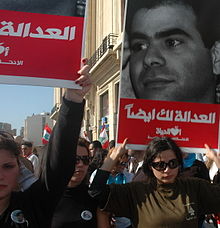 Demonstrators holding posters of slain minister and anti-Syrian figure Pierre Amine Gemayel
Demonstrators holding posters of slain minister and anti-Syrian figure Pierre Amine Gemayel
Bombings and assassinations
Beginning in March 2005 and continuing throughout the year, a series of bombings and assassinations rocked Lebanon. Several political and intellectual figures vocally critical of Syrian interference in Lebanese politics, including Samir Kassir, George Hawi, and Gebran Tueni were killed. In addition, Christian areas were targeted by bombs. These bombings remain unsolved.
The attacks did not end in 2005. The next year, gunmen killed MP Pierre Amine Gemayel, and in 2007, Walid Eido was killed by a car bomb in Beirut. Most recently, politician Antoine Ghanem was assassinated when a car bomb exploded, killing him on September 19, 2007. He is the 6th independentist minister assassinated since Hariri's death.
Withdrawal of Syrian troops
On April 26, 2005 international news agencies and the UN reported the last Syrian troops and intelligence agents had crossed the border in withdrawal from Lebanon. The Syrian government officially notified the United Nations that it had withdrawn its troops in line with UN Security Council Resolution 1559, adopted in September 2004. In a letter to the UN, Syrian Foreign Minister Farouq al-Shara said his country "would like to officially inform you that the Syrian Arab forces stationed in Lebanon, at the request of Lebanon and under an Arab mandate, have fully withdrawn all their military, security apparatus and assets." On April 27, 2005,[33] the Lebanese People celebrated for the first time their first day free from Syrian omnipresence.[34] Also on April 27, 2005, the Washington Post reported that "Syria has not withdrawn a significant part of its intelligence presence in Lebanon, undermining its claim yesterday to have ended its 29-year intervention in its western neighbor, U.S., European and U.N. officials said."[35] This claim was reiterated by US Secretary of State, Condoleezza Rice on May 25.[36]
Wave of democracy
Both participants and observers of the Cedar Revolution demonstrations have asked if the movement was influenced by recent local and regional events supporting democracy. Recent elections in Afghanistan, Iraq, and by the Palestinian Authority, a recent announcement that Egyptian President Hosni Mubarak will allow multiparty elections, and recent limited municipal elections in the Kingdom of Saudi Arabia, as well as the Orange Revolution in Ukraine, may have provided examples of movement toward democratic governance[citation needed]. Lebanese Druze leader Walid Jumblatt remarked to a reporter of the Washington Post, "It's strange for me to say it, but this process of change has started because of the American invasion of Iraq. I was cynical about Iraq. But when I saw the Iraqi people voting three weeks ago, 8 million of them, it was the start of a new Arab world". In this sense, the Cedar Revolution might be seen as a dividend of the Bush administration's global war on terror.
Other views maintain that Lebanese anger against perceived Syrian hegemony had been simmering for decades, and the assassination of a popular leader was the spark that gave birth to the movement, independently of foreign and regional developments. Lebanese opposition leader and newspaper columnist Samir Kassir, for example, wrote that "democracy is spreading in the region not because of George Bush but despite him." He gave far more credit to the Palestinian uprising as an inspiration to Lebanese activists.[37]
Others caution that very little has actually changed, apart from the mainly "cosmetic" disappearance of Syrian Soldiers from their presence on the outskirts of Lebanese cities, and that Syrian control of Lebanese foreign affairs and trade may yet endure. Some critics argue that the rush to celebrate a supposed 'Revolution' was far too premature.[38]
When Omar Karami failed to form a government, he resigned for good on April 13, 2005, and elections were called for the period of May 29 through June 19, 2005. Saad al-Hariri formed an anti-Syrian bloc that, ultimately, won 72 of the 128 available seats in the unicameral National Assembly.
Second Anniversary
On February 14, 2007, hundreds of defiant Lebanese gathered peacefully in Martyr’s Square to commemorate the second anniversary of former Prime Minister Rafik Hariri's assassination. The large number proved that the Cedar Revolution was still going on, especially when the crowds turned the commemoration into a defiant opportunity to blame Syria and Hezbollah for Lebanon's political woes.[39] The demonstrators fell silent at exactly 12:55 PM, the time of the explosion that killed Hariri on Feb. 14, 2005. Only the muezzin making the Islamic call to prayer and the solemn tolling of church bells could be heard.[40]
The Bikfaya bombings had taken place the day before, killing three people. Fatah al-Islam was blamed.
Third Anniversary
On the 14th of February, exactly three years from the day Premier Hariri was assassinated on the Beirut seafront, throngs of protesters rallied in Martyr's Square to commemorate the occasion. The crowd came from all over Lebanon. Hundreds of thousands of protesters filled the square and its immediate surrounding. In the mountainous areas, the weather conditions prevented several processions from reaching Beirut. Also, processions closed all roads east, north & south Beirut leading to Martyr's Square. Hundreds of boats embarked on a ride from the Jounieh port in the coast of Mount Lebanon to the Beirut Marina defying the winter waves. The rally was reaching its end while thousands of vehicles carrying protesters were still trapped in traffic in the Eastern Suburbs of Beirut. The crowds stood for more than 5 hours under the pouring the rain. The protesters transformed this event into an occasion to blame Syria and renew their oath to remain united and defiant for Lebanon's sake. At the exact time the explosion occurred 3 years ago at 12:55, the crowds fell silent as the Islamic prayers blared through the mosques' muezzin along with the lordly tolling of church bells symbolizing the Muslim-Christian unity. The leaders of the Anti-Syrian coalition gave fiery speeches blaming Syria & Iran for Lebanon's woes. Saad Hariri, the coalition's most popular leader, was the last to take the stand as supporting cheers blared from the crowds. In the end and after the crowds have stood for four consecutive hours under the pouring rain, the rally was concluded and the area was evacuated.
Fourth Anniversary
February 14, 2009 marked the fourth anniversary of Prime Minister Rafik Hariri's assassination. Estimated to be more than 1 million supporters, pro-government and pro-Hariri citizens of different sects and factions gathered together in Beirut for the occasion. At 12:55 pm, the crowd went silent to mark the exact moment of the explosion that killed Hariri.
The rally was also a peaceful reply to the pro-Syrian groups (Hizbullah and Amal Movement) that invaded Beirut on May 7, 2008 and took control of the city using force, before handing it to the Army after seven days, in which an estimated 100 people were killed as a result of the violent clashes that happened.[citation needed]
During the rally, speeches were given to entice the citizens to take place in the June 2009 parliamentary elections, in which the anti-Syrian coalition and the pro-Syrian coalition competed for the majority of seats.
Fifth Anniversary
Despite initial enthusiasm, the turn-out on the fifth anniversary of Hariri's assassination (February 14th 2010) was hindered due to heavy rain.
Sixth Anniversary
The sixth anniversary of Hariri's assassination, on February the 14th 2011, was met with renewed enthusiasm by supporters of the March 14 coalition. This was especially fueled by the protesters' anger over the resignation of all ten ministers aligned with the opposing March 8 coalition due to then-Prime Minister Saad Hariri, Rafik Hariri's son, refusal of Hezbollah's demand he reject the Special Tribunal For Lebanon. A rally was also organized to call for Hezbollah's disarmament on the day of March 13 in Beirut's Martyrs' Square.No significant disruptions took place, but it was reported by several TV stations that some protesters had their signs demanding Hezbollah's disarmament confiscated. Reuters approximated that 800,000 of supporters of Saad Hariri and his allies rallied against Hezbollah's weapons. [41][42]
See also
- Color revolutions - as a series of related movements
- 2007 Lebanon conflict
- Kurt Schock, Unarmed Insurrections: People Power Movements in Nondemocracies, University of Minnesota Press, 2005.
References
- ^ http://www.allacademic.com/meta/p_mla_apa_research_citation/1/5/1/5/0/p151501_index.html
- ^ Guerin, Orla (March 6, 2005). "Syria sidesteps Lebanon demands". BBC News. http://news.bbc.co.uk/2/hi/middle_east/4322477.stm. Retrieved April 28, 2010.
- ^ Remarks on Release of Country Reports on Human Rights Practices for 2004
- ^ Morley, Jefferson (March 3, 2005). "The Branding of Lebanon's 'Revolution'". The Washington Post. http://www.washingtonpost.com/wp-dyn/articles/A1911-2005Mar2.html. Retrieved April 28, 2010.
- ^ Daily Times - Leading News Resource of Pakistan
- ^ As the Globe spins: Coverage of Lebanon's demonstrations doesn't tell whole story (by Greg Felton) - Media Monitors Network (MMN)
- ^ AM (2005). "Lebanon Asks AFP to Investigate Assassination of PM". Retrieved November 2, 2006.
- ^ "Lebanon appoints prime minister". BBC News. October 21, 2004. http://news.bbc.co.uk/1/hi/world/middle_east/3763120.stm. Retrieved April 28, 2010.
- ^ The New York Times > International > Middle East > Behind Lebanon Upheaval, 2 Men's Fateful Clash
- ^ "Who's who in Lebanon". BBC News. March 14, 2005. http://news.bbc.co.uk/1/hi/world/middle_east/4348129.stm. Retrieved April 28, 2010.
- ^ The New York Times > International > Middle East > U.N. Cites Syria as Factor in Lebanese Assassination
- ^ a b "Lebanon agrees to Hariri inquiry". BBC News. March 25, 2005. http://news.bbc.co.uk/2/hi/middle_east/4383321.stm. Retrieved April 28, 2010.
- ^ "Beirut protesters denounce Syria". BBC News. February 21, 2005. http://news.bbc.co.uk/1/hi/world/middle_east/4283543.stm. Retrieved April 28, 2010.
- ^ Ghattas, Kim (March 3, 2005). "Lebanon finds unity in street rallies". BBC News. http://news.bbc.co.uk/2/hi/middle_east/4315223.stm. Retrieved April 28, 2010.
- ^ "Lebanese ministers forced to quit". BBC News. February 28, 2005. http://news.bbc.co.uk/2/hi/middle_east/4305927.stm. Retrieved April 28, 2010.
- ^ "Hariri inquiry judge 'may resign'". BBC News. March 23, 2005. http://news.bbc.co.uk/1/hi/world/middle_east/4375835.stm. Retrieved April 28, 2010.
- ^ The Independent (London). http://news.independent.co.uk/world/fisk/story.jsp?story=619657. Retrieved April 28, 2010.
- ^ "Annan considers new Hariri probe". BBC News. March 23, 2005. http://news.bbc.co.uk/1/hi/world/middle_east/4375325.stm. Retrieved April 28, 2010.
- ^ Beirut-Online News .: Syria's closure of northern Lebanon border tragic for truckers :
- ^ "Assad pledges Lebanon withdrawal". BBC News. March 2, 2005. http://news.bbc.co.uk/2/hi/middle_east/4310699.stm. Retrieved April 28, 2010.
- ^ a b The Daily Star - Politics - Saudi ruler demands rapid Syrian withdrawal
- ^ "Syria looks to Riyadh for support". BBC News. March 3, 2005. http://news.bbc.co.uk/2/hi/middle_east/4315107.stm. Retrieved April 28, 2010.
- ^ . http://www.theaustralian.news.com.au/common/story_page/0,5744,12813616%255E2703,00.html.[dead link]
- ^ Saleh, Heba (March 23, 2005). "Summits that showcase Arab disunity". BBC News. http://news.bbc.co.uk/2/hi/middle_east/4376599.stm. Retrieved April 28, 2010.
- ^ http://story.news.yahoo.com/news?tmpl=story&ncid=721&e=1&u=/nm/20050306/wl_nm/lebanon_hizbollah_dc
- ^ "Hezbollah rallies Lebanese to support Syria". CNN. March 9, 2005. http://www.cnn.com/2005/WORLD/meast/03/08/lebanon.syria/index.html. Retrieved April 28, 2010.
- ^ The New York Times > International > Middle East > Hezbollah Leads Huge Pro-Syrian Protest in Central Beirut
- ^ http://www.aljazeera.com/me.asp?service_ID=7326
- ^ Washington Times - Hezbollah supporters stage massive pro-Syria rally
- ^ CJR: Who Are Those Guys, Anyway?
- ^ The New York Times. http://www.nytimes.com/reuters/international/international-lebanon.html.[dead link]
- ^ The Washington Post. http://www.washingtonpost.com/wp-dyn/articles/A33571-2005Mar14.html?nav=headlines.[dead link]
- ^ DEMOCRACY IN LEBANON CELEBRATES LIBERATION - Press Release - عيد الجلاء: 27 نيسان
- ^ DEMOCRACY IN LEBANON - Post-Liberation Address - خطاب الجلاء
- ^ Wright, Robin (April 27, 2005). "Syrian Intelligence Still in Lebanon". The Washington Post. http://www.washingtonpost.com/wp-dyn/content/article/2005/04/26/AR2005042601264.html. Retrieved April 28, 2010.
- ^ "Cedar Revolution moves towards free democracy". The Sydney Morning Herald. May 28, 2005. http://www.smh.com.au/news/World/Cedar-Revolution-moves-towards-free-democracy/2005/05/27/1117129897892.html?oneclick=true.
- ^ The Washington Post. http://www.washingtonpost.com/wp-co/hotcontent/index.html?section=world/mideast.
- ^ The Daily Star - Opinion Articles - Cosmetic change does not a revolution make
- ^ Reuters AlertNet - Lebanese turn Hariri memory into show of defiance
- ^ http://news.yahoo.com/s/ap/20070214/ap_on_re_mi_ea/lebanon
- ^ "Lebanese call on Hezbollah to give up weapons accessdate=April 19, 2011". Reuters. Reuters. 13-03-2011. http://af.reuters.com/article/worldNews/idAFTRE72C28Y20110313?pageNumber=1&virtualBrandChannel=0.
- ^ Najem Malak (13-03-2011). "March 14 crowds in Beirut say no to Hezbollah weapons". AKNews. AKNews. http://www.aknews.com/en/aknews/4/224847/?AKmobile=true. Retrieved March 20, 2011.
External links
- World Council for the Cedars Revolution
- Independence Movement "Harakat Al Istiklal" Official website
- Lebanese March 14 Movement
- Lebanese March 14 Movement's General Secretariat
- Future Movement Official website
- Lebanese Forces Official website
- Tajaddod/Democratic Renewal Youth's Blog
- Cedar Revolution Photo Gallery
- Lebanese March 14 Emigrant Assembly
 Political blocs in Lebanon
Political blocs in LebanonGovernment (71) March 8 Alliance (33)Amal Movement (13) · Hezbollah (12) · Baath Arab Socialist Party (2) · Syrian Social Nationalist Party (2)Change and Reform bloc (25)Free Patriotic Movement (19) · Lebanese Democratic Party (4) · Marada Movement (3) · Armenian Revolutionary Federation (Tashnag) (2) · Solidarity Party (1) · Skaff BlocOthers (13)Progressive Socialist Party (11) · Glory Movement (Harakat Majd) (2) · Arab Democratic Party · Lebanese Communist Party · People's MovementOpposition (45) March 14 Alliance (45)Future Movement (26) · Lebanese Forces (8) · Kataeb Party (5) · Social Democrat Hunchakian Party (Hunchak Party) (2) · Armenian Democratic Liberal Party (Ramgavar Party) (1) · Democratic Left (1) · Islamic Group (1) · National Liberal Party (1) · Democratic Renewal Movement · Free Shia Movement · Independence Movement · Lebanese National Bloc · Tripoli BlocAnti-government protests in the 21st century Revolutions
and uprisings- Bahraini uprising (2011)
- Egyptian revolution (2011)
- Libyan civil war (2011)
- Syrian uprising (2011)
- Tunisian Revolution (2010–2011)
- Yemeni uprising (2011)
Other- Second intifada (2000-2005)
- Kyrgyzstani revolution (2010)
- Lebanese Cedar Revolution (2005)
Other Global protests- "Occupy" protests (2011–present)
- Protests against the war in Afghanistan (2001–present)
- Protests against the war in Iraq (2003–2011)
- Protests against world food prices (2007–2008)
Arab Spring- Algerian protests (2010–2011)
- Djiboutian protests (2011)
- Israeli border demonstrations (2011)
- Iraqi protests (2011)
- Jordanian protests (2011)
- Lebanese protests (2011)
- Mauritanian protests (2010–2011)
- Moroccan protests (2011)
- Omani protests (2011)
- Saudi Arabian protests (2011)
- Sudanese protests (2011)
- Western Saharan protests (2011)
- Austrian protests (2009)
- Canadian strikes (2005)
- Chilean protests (2006)
- Chilean protests (2008)
- Colombian protests (2011)
- Croatian protests (2009)
- Dutch strikes (2007)
- Irish protests (2010)
- Puerto Rican strikes (2010–2011)
- UK protests (2011)
- California college tuition hike protests (2009)
Other protests- Albanian opposition demonstrations (2011)
- Argentinian riots (2001)
- Armenian presidential election protests (2008)
- Armenian protests (2011)
- Azerbaijani protests (2011)
- Bolivian protests (2011)
- Burkinabé protests (2011)
- Cameroonian anti-government protests (2008)
- Canadian anti-prorogation protests (2010)
- Chilean Magellanic protests (2011)
- Chilean protests (2011)
- Chinese protests (2011)
- Croatian protests (2011)
- French civil unrest (2005)
- French pension reform strikes (2010)
- Georgian demonstrations (2007)
- Georgian protests (2011)
- Greek riots (2008)
- Greek protests (2010–2011)
- Hungarian protests (2006)
- Hong Kong democracy demonstration (2005)
- Hong Kong universal suffrage demonstration (2010)
- Hong Kong Anti-budget demonstration (2011)
- Icelandic financial crisis protests (2009)
- Indian anti-corruption movement (2011)
- Iranian election protests (2009–2010)
- Iranian protests (2011)
- Israeli reserve soldiers' protest (2006)
- Israeli housing protests (2011)
- Kurdish protests in Iraq (2011)
- Kurdish protests in Turkey (2011)
- Malaysian HINDRAF rally (2007)
- Malaysian Bersih rally (2007)
- Malaysian Bersih 2.0 rally (2011)
- Malawi protests (2011)
- Mexican protests (2011)
- Moldova civil unrest (2009)
- Nepalese democracy movement (2006)
- Portuguese protests (2011)
- Russian Dissenters March (2005–2008)
- Sahrawi protest camp at Gdeim Izik (2010)
- Catalan autonomy protest in Spain (2010)
- Spanish protests (2011)
- Tamil diaspora protests against Sri Lanka (2009)
- Tamil diaspora protests against Sri Lanka in Canada (2009)
- Turkish Republic Protests (2007)
- UK anti-austerity protests (2011)
- US Tea Party protests (2009–2010)
- US public employee protests (2011)
- Wisconsin citizen protests (2011)
Categories:- Conflicts in 2005
- Nonviolent revolutions
- History of Lebanon
- Politics of Lebanon
- Political alliances in Lebanon
- 2005 in Lebanon
- Lebanon–Syria relations
- Intifadas
- Protests in Lebanon
- 21st-century revolutions
Wikimedia Foundation. 2010.

